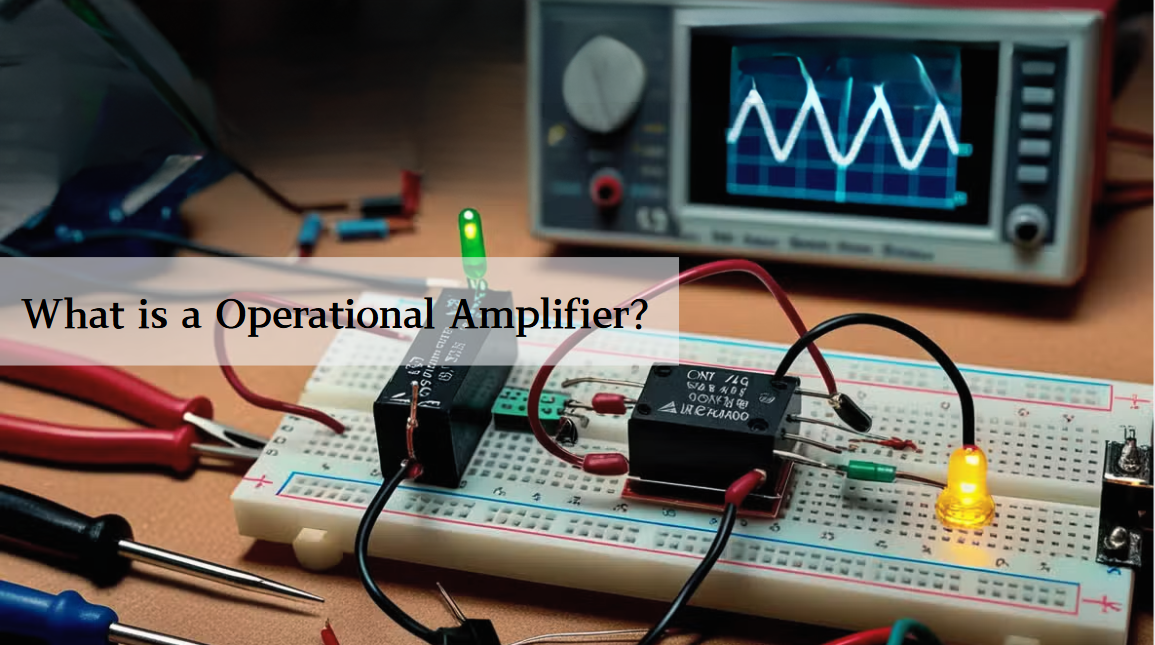An Operational Amplifier (Op-Amp) is a high-gain, linear integrated circuit (IC) designed to amplify the voltage difference between two input signals and produce a single output signal. It features two input terminals—an inverting input (−) where the output is phase-reversed, and a non-inverting input (+) where the output matches the input phase—and one output terminal. Key to its functionality is negative feedback, created by connecting external components like resistors or capacitors between the output and inputs, which stabilizes gain and allows precise control over its behavior. Ideal op-amps exhibit infinite input impedance (no current flows into inputs, the "virtual open" concept) and zero output impedance, with a virtual short circuit between inputs (voltages at both inputs are equal, the "virtual short" concept). Op-amps are fundamental in analog circuits for tasks like signal amplification (inverting/non-inverting amplifiers), filtering, mathematical operations (summing, integration, differentiation), and signal conditioning. Their versatility stems from configurable feedback networks, making them essential in applications ranging from audio processing and sensor amplification to precision measurement and control systems. Despite real-world limitations like finite gain and bandwidth, op-amps remain a cornerstone of modern electronics due to their reliability, ease of use, and adaptability.

1. Historical Development: The Journey from Vacuum Tubes to Integrated Circuits
The 1960s brought a revolution with integrated circuits (ICs). In 1963, Robert J. Widlar at Fairchild Semiconductor introduced the μA702, the first monolithic op-amp IC, shrinking the device from a roomful of tubes to a tiny chip. The μA741, launched in 1968, became an electronics staple. Its versatility and ease of use democratized signal processing, appearing in everything from calculators to stereo systems.Today, op-amps come in compact surface-mount packages, offering unmatched performance in gain, energy efficiency, and noise reduction, solidifying their role as a cornerstone of modern electronics.
2. Architectural Breakdown: The Inner Workings of a Three-Terminal Device
Terminals:
Power Supply: Connects to a voltage source, often dual (±15V for bipolar signals) or single (3.3V/5V for unipolar systems).
Inputs:
Non-inverting Input (+): Signals here appear at the output with the same polarity.
Inverting Input (-): Signals here are inverted at the output.
Output: Delivers the amplified signal, capable of driving loads like speakers or sensors.
Internal Architecture:
Differential Input Stage: Detects voltage differences while rejecting common-mode noise.
Gain Stage: Provides high open-loop gain, stabilized by feedback in practical circuits.
Output Stage: Ensures the signal can drive loads, even at low impedance.
3. Types of Op-Amps: Tailored for Every Task
Op-amps are categorized by design and performance to suit specific applications:
| Type | Key Traits | Where They Excel |
|---|---|---|
| General-Purpose | Balanced performance; affordable (e.g., LM741) | Basic amplifiers, student projects |
| High-Precision | Low offset voltage (μV ); ideal for delicate measurements (e.g., OPA277) | Medical devices, scientific instruments |
| High-Speed | Handles high frequencies (e.g., OPA657) | Wireless communication, video processing |
| Low-Power | Microamp-level current draw (e.g., TLC272) | Wearables, IoT sensors |
| Rail-to-Rail | Output swings to power supply limits (e.g., AD8541) | Mobile devices, audio mixers |
| Power Op-Amps | High output current (e.g., LM386) | Audio amplifiers, motor drives |
| Isolation Op-Amps | Electrical safety barrier (e.g., AD210) | Medical equipment, industrial control |
4. Critical Op-Amp Parameters
Understanding these specs is key to selecting the right op-amp:
Gain: Open-loop gain is high but unstable; closed-loop gain (with feedback) is controlled.
Input Impedance: High impedance preserves weak signals, critical for sensors.
Output Impedance: Low impedance ensures strong signal delivery to loads.
Bandwidth: The frequency range the op-amp can amplify effectively.
Slew Rate: How fast the output can change, vital for sharp signals.
Noise & Offset Voltage: Lower values mean cleaner, more accurate amplification.
Op-amps, paired with external components, excel in diverse applications:
5. What Op-Amps Can Achieve?
Signal Amplification:
Inverting Amplifier: Flips signal polarity, used in audio processing.
Non-inverting Amplifier: Boosts signals without polarity change, ideal for sensors.
Voltage Follower: Buffers signals to prevent interference between circuit stages.
Signal Processing:
Filters: Remove unwanted frequencies, e.g., in phone calls.
Rectifiers: Convert AC to DC for charging devices.
Advanced Operations:
Summing Circuits: Mix signals in music recorders.
Integration/Differentiation: Analyze signal changes over time in control systems.
6. Operational Modes and Feedback Magic
Op-amps rely on two key principles:
Virtual Short: Inputs act as if they’re at the same voltage, forced by the op-amp’s high gain.
Virtual Open: Almost no current flows into the inputs, preserving signal integrity.
Feedback Types:
Open-Loop (No Feedback): Used in voltage comparators to detect signal thresholds.
Closed-Loop (With Feedback): Stabilizes gain for amplifiers and filters.
7. Power Supply and Signal Modes
Dual-Supply Op-Amps: Use ± voltages for bipolar signals (e.g., audio waves).
Single-Supply Op-Amps: Run on one positive voltage, popular in battery devices.
Signal Modes:
Differential: Amplifies the difference between two inputs.
Common-Mode: Rejects identical signals on both inputs.
Single-Ended: One input grounded, for basic amplification.
8. Advantages and Limitations
| Strengths | Limitations |
|---|---|
| High gain for weak signals | Bandwidth limits at high frequencies |
| Flexibility via feedback | Power constraints in high-demand apps |
| Low cost and wide availability | Temperature sensitivity |
| High input impedance | Noise vulnerability in sensitive systems |
9. Real-World Applications
Op-amps are indispensable in:
Consumer Electronics: Audio amplifiers, voltage regulators in chargers.
Industrial & Scientific: Sensor signal conditioning, precision lab equipment.
Communication Systems: Filtering and amplifying radio signals in smartphones.
Robotics & Control: PID controllers for motor speed adjustment.
10. Selecting the Right Op-Amp
Key considerations:
Signal Type: Choose high-precision for weak signals, high-speed for digital edges.
Power Supply: Single for batteries, dual for bipolar signals.
Environment: High-temperature stability or compact packaging as needed.
Budget: General-purpose for prototyping, specialized for critical applications.
11. Real vs. Ideal Op-Amps
Finite Gain: Requires feedback for stability.
Impedance Limits: High but not infinite input impedance; low but non-zero output impedance.
Noise & Drift: Advances like zero-drift technology minimize these issues.
12. SIC: Your Trusted Op-Amp Partner
Precision Op-Amps: For medical and scientific applications.
High-Speed Op-Amps: For wireless and data acquisition systems.
Low-Power Op-Amps: For battery-powered devices.
With rigorous quality control and expert support, SIC empowers your designs with cutting-edge analog performance. Contact us at sales@sic-components for datasheets and tailored solutions.
Conclusion
Operational amplifiers are the unsung heroes of electronics, enabling everything from audio clarity to industrial precision. By understanding their history, types, and parameters, you gain the tools to design robust, efficient circuits. Whether for a simple amplifier or a complex sensor system, the right op-amp turns challenges into innovations, proving that small components can drive big impacts.
This translation maintains technical depth while enhancing readability for an international audience, suitable for technical documentation, educational materials, or professional publications.









 Wishlist (0 Items)
Wishlist (0 Items) 